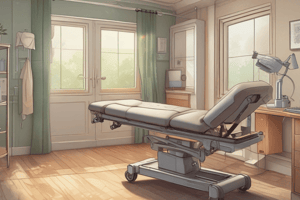Podcast
Questions and Answers
What is a backboard used for?
What is a backboard used for?
- To assist in lifting patients with a suspected head injury
- To provide support to a patient suspected of having a spinal injury (correct)
- To carry patients down stairs
- To transport patients who are conscious
What is bariatrics?
What is bariatrics?
A branch of medicine concerned with the management of obesity and allied diseases.
A basket stretcher is also called a Stokes litter.
A basket stretcher is also called a Stokes litter.
True (A)
Define body mechanics.
Define body mechanics.
What is a diamond carry?
What is a diamond carry?
Describe a direct ground lift.
Describe a direct ground lift.
What is an emergency move?
What is an emergency move?
What is an extremity lift?
What is an extremity lift?
What is a flexible stretcher?
What is a flexible stretcher?
What characterizes a portable stretcher?
What characterizes a portable stretcher?
Explain the power lift technique.
Explain the power lift technique.
What is the purpose of the rapid extrication technique?
What is the purpose of the rapid extrication technique?
Describe a scoop stretcher.
Describe a scoop stretcher.
What is a stair chair?
What is a stair chair?
What is a wheeled ambulance stretcher?
What is a wheeled ambulance stretcher?
Define power grip.
Define power grip.
Explain a sling lift.
Explain a sling lift.
What are the key principles of reaching and pulling?
What are the key principles of reaching and pulling?
What is the purpose of body drag?
What is the purpose of body drag?
When log rolling onto a backboard, you should lean forward and keep your back _____.
When log rolling onto a backboard, you should lean forward and keep your back _____.
In a one hand carry, you should face each other and lift the backboard to carrying _____.
In a one hand carry, you should face each other and lift the backboard to carrying _____.
What is an intravenous (IV) pole?
What is an intravenous (IV) pole?
Flashcards are hidden until you start studying
Study Notes
Patient Movement Tools and Techniques
- Backboard: Rigid flat board for patients with potential hip, pelvic, spinal, or lower extremity injuries. Supports patients in a supine position; also known as a spine board or trauma board.
- Bariatrics: Medical field focusing on obesity management and related health issues.
- Basket Stretcher: Rigid stretcher for technical rescues, allows water drainage through holes. Known as Stokes litter.
- Body Mechanics: Investigates the interaction between body structures and forces in lifting, moving, and carrying, emphasizing optimal movement techniques.
- Diamond Carry: A coordinated lifting method by four EMTs around a stretcher, allowing each to face forward while carrying the patient.
- Direct Ground Lift: Lifting technique for patients lying supine on the ground without suspected spinal injuries.
- Emergency Move: Quick extraction of a patient from a dangerous scene before complete assessment and care.
- Extremity Lift: Used for supine or seated patients with no suspected extremity or spinal injuries, ensuring safe lifting.
- Flexible Stretcher: Becomes rigid when secured around a patient but can be easily folded or rolled for storage.
- Portable Stretcher: Strong, rectangular stretcher with a metal frame and rigid fabric for transporting patients.
Lifting Techniques
- Power Lift: Lifting stance with an upright back and bent legs, raising the upper body by straightening legs.
- Rapid Extrication Technique: Fast conversion of a vehicle patient from a sitting position to supine on a backboard in under a minute.
- Scoop Stretcher: Composed of split sections to encase a patient on a flat surface; also called an orthopedic stretcher.
- Stair Chair: Lightweight device for safely transporting conscious, seated patients up or down stairs.
- Wheeled Ambulance Stretcher: Collapsible stretcher rollable on the ground, designed for ambulance use; also referred to as the ambulance stretcher.
Lifting and Pulling Techniques
- Power Grip: Proper handle grasp with palms and thumbs positioned upwards for effective lifting.
- Sling Lift: Utilizes a sling and hydraulic lift to transfer patients from a bed to a chair.
- Reaching and Pulling: Techniques for safely pulling patients; involves kneeling, controlled elbow movement, and proper stance for balance.
- Body Drag: Maintain back integrity by tightening abs while pulling a patient; involves specific arm extension and repositioning.
- Log Rolling onto a Backboard: Technique for lateral patient transfer to a backboard, focusing on body alignment and knee positioning.
Specialty Techniques
- One Hand Carry: Cooperative lifting technique where providers transition from two-handed to one-handed grips to facilitate movement.
- Intravenous (IV) Pole: Device attached to stretchers for managing IV fluids during patient transport.
Studying That Suits You
Use AI to generate personalized quizzes and flashcards to suit your learning preferences.




